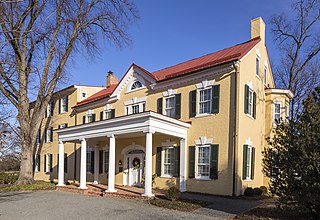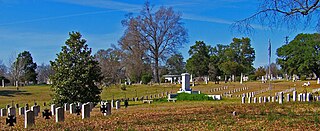
Pinehurst is a village in Moore County, North Carolina, United States. As of the 2020 census, the village population was 17,581. It is home of the historic Pinehurst Resort, a Golf resort, which has hosted multiple United States Open Championships in the sport. The village lies adjacent to the Pine Needles Lodge and Golf Club, which has hosted multiple U.S. Open tournaments in Women's Golf. A large portion of the central village, including the resort complexes, is a National Historic Landmark District, designated in 1996 for its landscape design and its significance in the history of golf in the United States. Pinehurst has been designated as the "Home of American Golf" by the United States Golf Association, which announced a second headquarters in the village in 2020. The area is also known for its strong equestrian community, has hosted the former Stoneybrook Steeplechase, and currently maintains the Pinehurst Harness Track. Fox hunting is also a common sport in the area.

Eudora Alice Welty was an American short story writer, novelist and photographer who wrote about the American South. Her novel The Optimist's Daughter won the Pulitzer Prize in 1973. Welty received numerous awards, including the Presidential Medal of Freedom and the Order of the South. She was the first living author to have her works published by the Library of America. Her house in Jackson, Mississippi has been designated as a National Historic Landmark and is open to the public as a house museum.

Yaddo is an artists' community located on a 400-acre (160 ha) estate in Saratoga Springs, New York. Its mission is "to nurture the creative process by providing an opportunity for artists to work without interruption in a supportive environment." On March 11, 2013 it was designated a National Historic Landmark.

Wave Hill is a 28-acre (11 ha) estate in the Hudson Hill section of Riverdale in the Bronx, New York City. Wave Hill currently consists of public horticultural gardens and a cultural center, all situated on the slopes overlooking the Hudson River, with expansive views across the river to the New Jersey Palisades. The estate includes two houses and a botanical garden. The oldest part of the main house, Wave Hill House, dates to 1843; Glyndor House dates from 1927 and contains a multi-room art gallery. Perkins Visitor Center, which was originally a garage, contains a gift shop and an information desk.

Rowan Oak was the home of author William Faulkner in Oxford, Mississippi. It is a primitive Greek Revival house built in the 1840s by Colonel Robert Sheegog, an Irish immigrant planter from Tennessee. Faulkner purchased the house when it was in disrepair in 1930 and did many of the renovations himself. Other renovations were done in the 1950s. One of its more famous features is the outline of Faulkner's Pulitzer Prize–winning novel A Fable, penciled in graphite and red on the plaster walls of his office. It is now owned and operated by the University of Mississippi as a museum, and is open to visitors year-round.

Carl Sandburg Home National Historic Site, located at 81 Carl Sandburg Lane near Hendersonville in the village of Flat Rock, North Carolina, preserves Connemara, the home of Pulitzer Prize-winning poet and writer Carl Sandburg. Though a Midwesterner, Sandburg and his family moved to this home in 1945 for the peace and solitude required for his writing and the more than 30 acres (120,000 m2) of pastureland required for his wife, Lilian, to raise her champion dairy goats. Sandburg spent the last twenty-two years of his life on this farm and published more than a third of his works while he resided here.

The Mount (1902) is a country house in Lenox, Massachusetts, the home of noted American author Edith Wharton, who designed the house and its grounds and considered it her "first real home." The estate, located in The Berkshires, is open to the public. The property was declared a National Historic Landmark in 1971.

Bok Tower Gardens is a 250-acre (100 ha) contemplative garden and bird sanctuary located atop Iron Mountain, north of Lake Wales, Florida, United States, created by Edward Bok in the 1920s. Formerly known as the Bok Mountain Lake Sanctuary and Singing Tower, the gardens' attractions include the Singing Tower and its 60-bell carillon, the Bok Exedra, the Pinewood Estate now known as El Retiro, the Pine Ridge Trail, and the Visitor Center.

The Dallas Arboretum and Botanical Garden is a 66-acre (27 ha) botanical garden located at 8525 Garland Road in East Dallas, Texas, on the southeastern shore of White Rock Lake.

The Morris–Butler House is a Second Empire-style house built about 1864 in the Old Northside Historic District of Indianapolis, Indiana. Restored as a museum home by Indiana Landmarks between 1964 and 1969, the American Civil War-era residence was the non-profit organization's first preservation project. Restoration work retained some of its original architectural features, and the home was furnished in Victorian and Post-Victorian styles. Its use was changed to a venue for Indiana Landmarks programs, special events, and private rentals following a refurbishment in 2013. Regular daily tours of the property have been discontinued.

Dodona Manor, the former home of General George Catlett Marshall (1880–1959), is a National Historic Landmark and historic house museum at 312 East Market Street in Leesburg, Virginia. It is owned by the George C. Marshall International Center, which has restored the property to its Marshall-era appearance of the 1950s. It is nationally significant as the home of George C. Marshall, Chief of Staff of the United States Army during World War II, Secretary of State, President of the American Red Cross, and Secretary of Defense.

Greenwood Cemetery is a cemetery located in downtown Jackson, Mississippi. Still in use, it was established by a federal land grant on November 21, 1821. It was originally known simply as "The Graveyard" and later as "City Cemetery" before the present name was adopted in 1899. It is the final resting place of Confederate generals, former governors of Mississippi, mayors of Jackson, as well as other notable figures, the most recent of whom is internationally acclaimed author Eudora Welty. The graves of over 100 "unknown" Confederate soldiers are also located here. Greenwood Cemetery was listed on the National Register of Historic Places and as a Mississippi Landmark in 1984.

The Willa Cather House, also known as the Willa Cather Childhood Home, is a historic house museum at 241 North Cedar Street in Red Cloud, Nebraska. Built in 1878, it is the house where author Willa Cather (1873–1947) grew up. Cather's descriptions of frontier life in Nebraska were an important part of literary canon of the early 20th century. The house was declared a National Historic Landmark in 1971. The house is one of eight structures that make up the Willa Cather State Historic Site, which is owned by the Willa Cather Foundation.

Ripshin Farm, also known as the Sherwood Anderson Farm is a historic farm property at the junction of Routes 603 and 732 near Troutdale, Virginia. It was developed as a summer home and later year-round home by writer Sherwood Anderson (1876–1941), and is where he wrote most of his later works. It was declared a National Historic Landmark in 1971.
Hubert Creekmore was an American poet and writer from the small Mississippi town of Water Valley. Creekmore was born into one of the oldest Southern families of the area but he would grow up to embody ideals very different from the conservative Southern principles by which he was raised.
A Mississippi Landmark is a building officially nominated by the Mississippi Department of Archives and History and approved by each county's chancery clerk. The Mississippi Landmark designation is the highest form of recognition bestowed on properties by the state of Mississippi, and designated properties are protected from changes that may alter the property's historic character. Currently there are 890 designated landmarks in the state. Mississippi Landmarks are spread out between eighty-one of Mississippi's eighty-two counties; only Issaquena County has no such landmarks.

"Why I Live at the P.O." is a short story written by Eudora Welty, American writer and photographer. It was published in her collection of stories named A Curtain of Green (1941). The work was inspired by a photograph taken by Welty that depicts a woman ironing at the back of a post office. The story is classified as an example of Southern realism. "Why I Live at the P.O." is one of Welty's most popular and frequently anthologized stories.

The Gene Stratton-Porter Cabin, known as the Cabin at Wildflower Woods and the Gene Stratton-Porter State Historic Site, is the former home of Gene Stratton-Porter, a noted Indiana author, naturalist, and nature photographer. The two-story, fourteen-room cabin, which was built in 1914, is located at Sylvan Lake near Rome City in Noble County, Indiana. Stratton-Porter lived full-time in the cabin from 1914 through 1919, then relocated to homes in California, where she continued to write and founded a movie studio. She returned to Wildflower Woods in Rome City for brief visits until her death in 1924. The property was listed on the National Register of Historic Places in 1974.

Delta Wedding is a 1946 Southern fiction novel by Eudora Welty. Set in 1923, the novel tells of the experiences of the Fairchild family in a domestic drama-filled week leading up to Dabney Fairchild's wedding to the family overseer, Troy Flavin, during an otherwise unexceptional year in the Mississippi Delta.
The literature of Mississippi, United States, includes fiction, poetry, and nonfiction. Mississippi has a literary tradition that arose from a diverse mix of cultures and races. Traditional themes from this genre of literature lean towards the past, conflict and change, and southern history in general; however, in the modern era, work have shifted towards deeply Southern works that do not rely on these traditional themes.





















